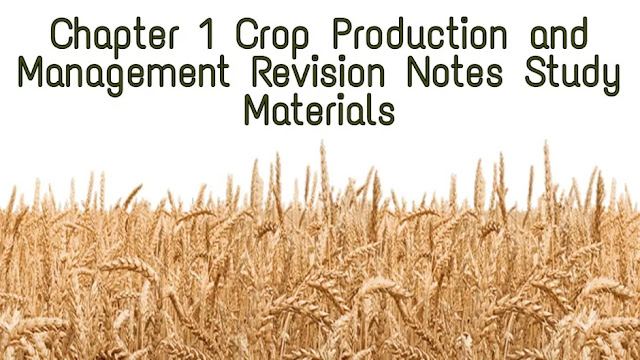Download pdf of Chapter 1 Crop Production and Management Class 8 Revision Notes
Crop Production and Management. Agriculture is the branch of science, which mainly deals with the different processes or the methods used for the cultivating different varieties of crops
Free PDF Download - Best collection of revision Notes, Important Questions, Sample papers and NCERT Solutions for CBSE Class 8 Science Crop Production and management
Crop: When plants of the same kind are cultivated at one place on a large scale it is called a crop .
For example crop of wheat means all plant grown in the field are that of wheat.
Crop can be classified on the basis of the season in which they grow.
Two types of cropping pattern are:-
1.Kharif crops: The crops which are sown in the rainy season (June to September) are called kharif crops.
Examples of kharif crops: Paddy, maize, soyabean, groundnut, cotton etc.
2.Rabi crops: The crops grown in the winter season (October to March) are called Rabi crops.
Example of Rabi crops: Wheat, Gram, pea, mustard, linseed etc.
Agricultural practices: The activities or tasks involved in crop production are called agricultural practices.
List of activities for crop production (agricultural practices):
1.Preparation of soil
2.Sowing
3.Adding manure and fertilizers
4.Irrigation
5.Protecting from weeds
6.Harvesting
7.Storage
1. Preparation of soil:
• It is the first step in crop production.
• It is one of the most important tasks.
• Preparation of soil involves turning and loosening the soil.
• It allows the root to penetrate deep into the soil.
• The loosened soil helps in the growth of earthworm and microbes present in the soil. They add humus to soil which helps in growth of plants.
Tilling/Ploughing: The process of loosening and turning of the soil is called tilling of ploughing. This is done by using a plough.
Agricultural implements: These are the tools used in the crop production.
1.Plough: Plough is used for tilling the soil, adding fertilizers to the crop, removing weeds and turning the soil.
2.Hoe: it is a simple tool which is used for removing weeds and for losing the soil.
3.Cultivator: Cultivators of tractor-driven (used with the help of a tractor).
It is used for ploughing.
2. Sowing:
• It is the process of spreading the seeds in the field.
• Sowing is done either by using traditional tools or a seed drill.
• Before sowing good-quality and healthy seeds are selected to give high yield.
3. Manure and fertilizers: The substance which are added to the soil in the form of nutrients for the healthy growth of plants are called manure and fertilizers.
Manure: Manure is an organic substance obtained from the decomposition of plants or animals wastes.
Fertilizers: Fertilizers are chemicals which are rich in a particular nutrient.
Example: urea, ammonium, NPK(nitrogen, Phosphorus, potassium).
Difference between manual and fertilizers:
Irrigation: The supply of water to crops at regular intervals is called irrigation.
Sources of irrigation: wells, tubewells, ponds, lakes, rivers, dams and canals.
Traditional methods of irrigation:
1.Moat (pully system)
2.Chain pump
3.Dhekli
4.Rahat (lever system)
Modern methods of irrigation:
1. Sprinkler system:
• Useful on uneven land where sufficient water is not available.
• In this system, perpendicular pipes having rotating nozzles on top, are joined to a main pipeline.
• Water is sprinkled on the crops through these rotating nozzles like rain.
2.Drip system:
• In this system the water falls drop by drop directly near the roots
• It is useful in such regions where water availability is poor.
• It is best techniques for watering fruit plants, gardens and trees.
Weeds: The unwanted plants that grow naturally along with the crop are called weeds.
Weeding: The removal of weeds is called weeding.
Weedicides: These are chemicals used to control weeds.These are sprayed in the field to kill the weeds.
Example: 2,4-D
Harvesting: The cutting of crops after it is mature (grown) is called
harvesting.
It is done by manually using a sickle or machine called harvester.
Threshing: The process of separating the grain seeds from the chaff is called threshing.
Granaries: A place where grains are stored and protected from pests like rats, insects etc.
Animal husbandry: When animals are provided with food, shelter and care for obtaining food from animal source is called animal husbandry.
%20(2)%20(1).webp)

Thanks for providing notes in pdf
ReplyDeleteThanks for your positive feedback.
DeletePost a Comment